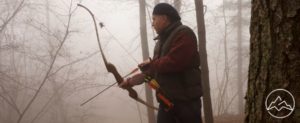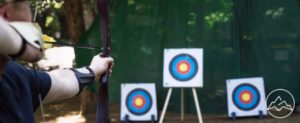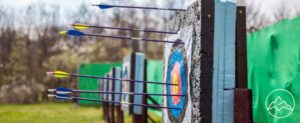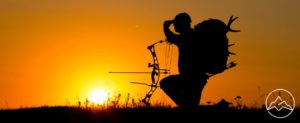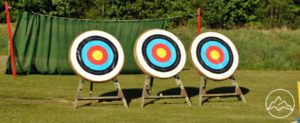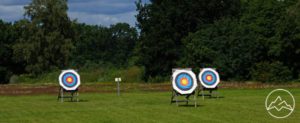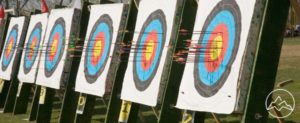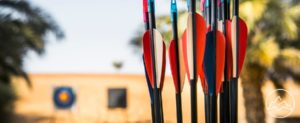Mastering archery in challenging conditions requires a combination of specialized gear, tactical prowess, and meticulous preparation. To navigate through adverse weather elements such as wind, rain, bright sunlight, and snow, archers must employ specific strategies that account for the impact of these conditions on accuracy and performance. Wind, for instance, alters the trajectory of arrows, necessitating the use of heavier projectiles and skillful aim adjustments. Rain affects visibility and grip, causing arrows to drop faster in heavy downpours. Bright sunlight can blind archers, making it crucial to shoot from shaded areas or with the sun at one’s back. Snowfall, similar to rain, demands adjustments in aiming and timing. Furthermore, extreme temperatures can significantly influence equipment range and accuracy. Thus, mastering archery in challenging conditions necessitates rigorous practice and careful consideration of gear and tactics to ensure optimal performance in any environment.
Key Takeaways
- Mastering archery in challenging conditions requires specialized gear, tactical prowess, and meticulous preparation.
- Adverse weather elements such as wind, rain, bright sunlight, and snow impact accuracy and performance.
- Understanding how weather conditions impact arrow precision is essential, similar to a skilled sailor navigating the seas.
- Regular practice in various weather conditions is crucial for developing necessary skills and adaptability.
Gear and Tactics
The success of shooting archery in challenging conditions heavily relies on the utilization of specialized gear and the implementation of effective tactics. When it comes to gear selection, it is crucial to choose equipment that can withstand the elements. This includes using waterproof and durable bows, arrows, and accessories. Additionally, selecting the appropriate arrow weight can improve accuracy in windy conditions. Heavier arrows are less affected by the wind, allowing for more consistent shots. In terms of shooting techniques, compensating for wind is essential. By aiming to the left or right of the target, archers can counteract the wind’s influence on arrow trajectory. Furthermore, practicing shooting in the shade can help improve distance estimation, as shooting in bright sunlight can affect the accuracy of bow sights. Overall, mastering archery in challenging conditions requires careful gear selection and the implementation of effective shooting techniques.
Weather Considerations
Adapting to the elements requires a deep understanding of how weather conditions can impact the precision and effectiveness of shooting arrows, much like how a skilled sailor navigates the unpredictable seas. When it comes to archery, handling wind and rain is crucial. Wind can significantly affect arrow trajectory, requiring archers to compensate by aiming to the left or right. Heavier arrows perform better in windy conditions, as they are less affected by the wind. Rain, on the other hand, affects visibility and grip. Arrows tend to drop faster in heavy rain, making it necessary to adjust aim accordingly. Additionally, bright sunlight can pose challenges, as it can be blinding and affect bow sights. Shooting from the shade or with the sun at your back can mitigate these issues. It is important for archers to practice shooting in different weather conditions to improve their skills and be prepared for any situation.
Practicing in Challenging Conditions
Practicing regularly in various weather conditions is essential for archers to develop the necessary skills to excel in challenging environments. By exposing themselves to different elements, archers can improve their accuracy and learn to adapt their techniques accordingly. For instance, practicing in windy conditions allows archers to understand how wind affects arrow trajectory and how to compensate by aiming to the left or right. Similarly, shooting in the rain or snow helps archers become accustomed to the decreased visibility and the effects it has on grip and equipment performance. Additionally, practicing in bright sunlight enables archers to develop strategies to reduce glare and maintain accuracy. By actively engaging in practice sessions in challenging conditions, archers can hone their skills, improve their adaptability, and ultimately become proficient in shooting archery in any element.
Frequently Asked Questions
How do I prevent my bow from freezing in extreme cold temperatures?
To prevent your bow from freezing in extreme cold temperatures, it is crucial to take proper precautions. One anecdote that illustrates this is the experience of a seasoned archer who, while shooting in freezing conditions, had their bow freeze solid, rendering it unusable. To avoid this, it is recommended to keep your bow indoors or in a heated area until ready to shoot. Additionally, applying a protective wax or lubricant to the bowstring and limbs can help prevent freezing. Regularly checking and cleaning your bow will ensure its functionality in extreme cold temperatures.
What are some strategies for shooting in strong gusts of wind?
Strategies for shooting in strong gusts of wind involve adjusting for the wind’s effect on arrow trajectory. Heavier arrows are more resistant to wind, so using them can improve accuracy. Aiming slightly to the left or right can compensate for wind direction. Additionally, finding a sheltered position or shooting with the wind at your back can help. Wind flags and indicators can also provide valuable information on wind speed and direction. Practice and experience are essential for mastering shooting in windy conditions.
Can I use a different type of arrow in heavy rain to maintain accuracy?
In heavy rain, using different arrow materials can help maintain accuracy. For instance, carbon arrows tend to be more resistant to moisture and therefore less affected by rain. Additionally, the importance of grip cannot be overstated in wet conditions. Ensuring a secure grip on the bow and arrow is crucial for maintaining control and accuracy. Therefore, using arrows with textured or rubberized coatings can provide better grip and enhance overall performance in heavy rain.
How do I protect my bow from water damage during a rainy archery session?
Protective gear and proper bow maintenance are crucial for protecting your bow from water damage during a rainy archery session. To safeguard your bow, consider using a waterproof bow case or cover to shield it from direct exposure to rain. Additionally, regularly applying a waterproofing solution to the bowstring and other vulnerable parts can help repel water and prevent damage. It is important to ensure that all equipment is thoroughly dried and properly stored after each rainy session to maintain its longevity.
Are there any specific techniques for shooting in snowy conditions to improve accuracy?
To improve accuracy when shooting in snowy conditions, several shooting techniques and equipment maintenance practices can be employed. Firstly, aiming slightly higher or waiting for the snowfall to slow down can compensate for the snow’s effect on arrow trajectory. Additionally, ensuring proper grip on the equipment, such as using gloves or applying grip enhancers, can help maintain control in snowy conditions. Regularly cleaning and drying the equipment after each session is also crucial to prevent damage and maintain performance.
Conclusion
Mastering archery in challenging conditions requires specialized gear, tactics, and preparation. From wind and rain to bright sunlight and snow, each weather condition presents its own set of challenges that can greatly impact accuracy and performance. It is important for archers to understand these effects and make necessary adjustments to their shooting techniques. Additionally, practicing in challenging conditions can help archers develop the necessary skills to excel in any element. By testing equipment performance and honing their abilities, archers can overcome the obstacles posed by extreme temperatures, rain, wind, and other weather conditions.


